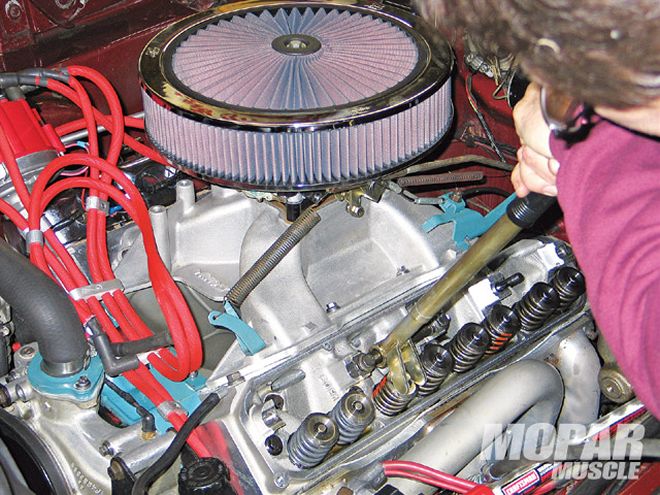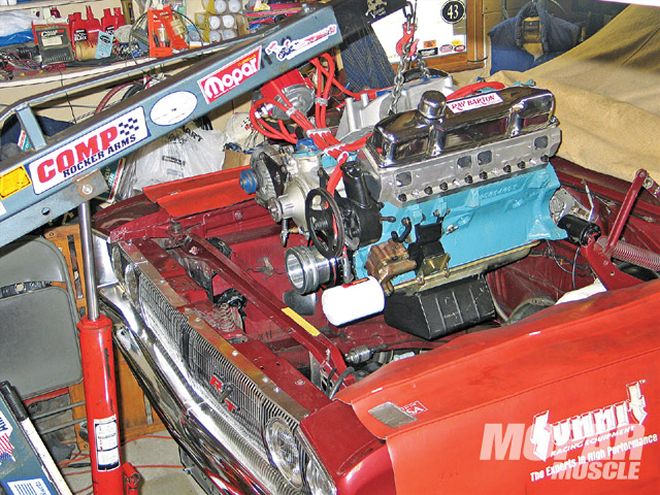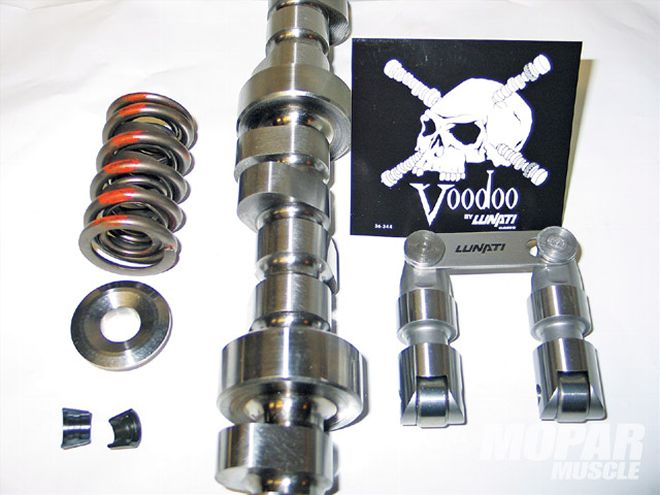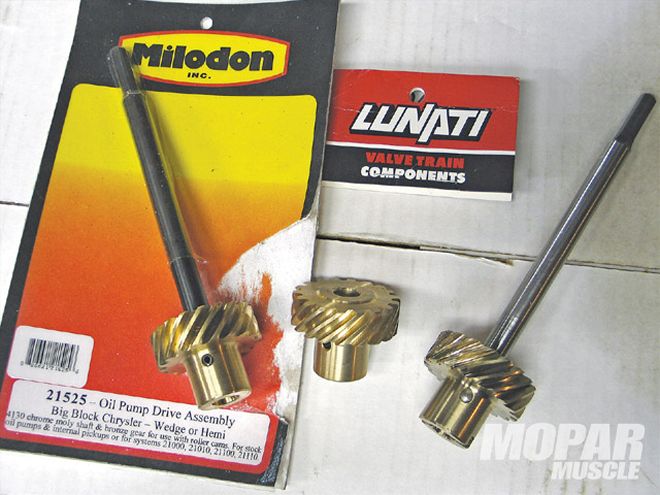

Choosing the right camshaft to match your engine combination can be confusing. It's also very important to use the proper valvetrain components that will work reliably with your camshaft of choice. Paying careful attention to the workings of the entire valvetrain is of the utmost importance. Don't wonder if everything will be OK (we did that about our spring pressure and oiling, and then paid the price-more on that later). Never hesitate to consult with a knowledgeable tech person from one of the cam company tech lines like those at Comp Cams. They want to help you pick the right cam and components for your combination.
 After a four-year run, it was time our Ray Barton-built 493 got some attention. The Barton team refreshed (ring, bearings, light hone) the short-block. Our engine configuration would be the same except for the implementation of a new camshaft. We decided to try one of Lunati's new VooDoo solid street roller cams. Also, we were interested to see how Lunati's latest stick would compete against the older street roller.
After a four-year run, it was time our Ray Barton-built 493 got some attention. The Barton team refreshed (ring, bearings, light hone) the short-block. Our engine configuration would be the same except for the implementation of a new camshaft. We decided to try one of Lunati's new VooDoo solid street roller cams. Also, we were interested to see how Lunati's latest stick would compete against the older street roller.
Back in 2003 we installed a solid-lift street roller camshaft for our 493ci RB engine in "Long Armed Wedge," from the June and July '03 issues. The roller camshaft had .575-inch lift and 262 degrees of duration at .050-inch on a 110-degree LSA. It helped our Ray Barton Wedge develop 660 lb/ft of torque at 4,100 rpm, and 621 hp at 5,600 rpm at the flywheel. That bumpstick proved to be the ideal choice for our street-driven combination, providing years of trouble-free service.
Eventually, we removed the 493 for a thorough inspection and refreshing. While planning our rebuild, we decided the 493 needed a cam with slightly less duration (7 degrees), to lower the powerband 200-300 rpm. We figured that would be just enough to match our eventual gear swap from 3.73s to 3.55s. We chose a Lunati VooDoo Solid roller stick with .600/.600-inch lift, and 255/263 degrees of duration at .050-inch, and we opted to keep a 110-degree LSA.
Once our refreshed engine with a new cam was broken in, we called our friends at SLP Performance Parts in nearby Toms River, New Jersey, for a dyno appointment. In their SuperFlow SF 840 dyno was the data saved from the original test when we used the first roller stick. Once at SLP, our buddies Ken Estelle (fabrication specialist) and Will Seppelt (project engineer) strapped the Coronet to the dyno. The engine and drivetrain combo would be the same except for the new VooDoo stick. The A/F (air/fuel mixture ratio) proved to be on the money while driving on the dyno at cruise (14.5 A/F) and WOT (12.8 A/F). The timing was set at 39 degrees total-same as it was when we tested the first camshaft.
 Lunati's VooDoo cams offer aggressive ramp profiles. Their roller lifters (PN 72421LUN) are ultra high quality for maximum durability. The high-pressure springs (PN 74650LUN) utilize 590 pounds of open pressure. We specified lightweight titanium retainers (PN 76185LUN) to enable us a few hundred more rpm before valve float could possibly occur.
Lunati's VooDoo cams offer aggressive ramp profiles. Their roller lifters (PN 72421LUN) are ultra high quality for maximum durability. The high-pressure springs (PN 74650LUN) utilize 590 pounds of open pressure. We specified lightweight titanium retainers (PN 76185LUN) to enable us a few hundred more rpm before valve float could possibly occur.
When Hank Daniecki, director of engineering, put the hammer down, the R/T's redline tires spun the rollers to a tune of 501 rwhp. We tried setting the timing at 32 and 36 degrees, and found our best pull of 503 rwhp using 36 degrees timing. Though we were down 20 rwhp with the new camshaft at the same 5,500-rpm peak as with the first camshaft, we were making 25 more hp at 5,100-5,200 rpm with the second one. Peak power may have been down at a higher rpm, but making more power at a lower rpm saves wear and tear on the engine. In this situation we should have used an engine dyno to show which cam made the best average power from 3,000 to 6,000 rpm. That would have determined the better bumpstick overall.
Most of us are on a mission seeking more power. So, next we plugged in Performance Distributors' new Mini-VIP 18-volt step-up regulator into our DUI distributor. On this dyno blast, we witnessed another 6 rwh-up to 509. The A/F went from 12.8 to 13.0. This was due to the better combustion from the stronger spark the Mini VIP provides. We had the possibility to pick up a few more horsepower by jetting up, but we were running out of dyno time.
While breaking-in the stroker wedge after the freshening, we test-drove the car using two of Holley's HP carbs-the 950 and the 1,000-cfm units. The smaller carb delivered better all-around drivability, but the bigger carb felt stronger above 5,000 rpm. To see the difference, we needed dyno numbers. We removed the 1,000 HP and bolted on the 950 HP and noticed a 5hp drop in power. The A/F proved to be perfect for both of the Holley carburetors.
 When using a roller cam, you must also use a bronze-type distributor/cam gear on the oil pump driveshaft. We used the Milodon (left, PN 21525) oil pump drive assembly. The Lunati (center, PN 88426) bronze gear could have been pressed on and pinned to the original shaft by a local machine shop. The gear (right) has over 8,000 miles on it. Inspect the bronze gear for wear every few thousand miles.
When using a roller cam, you must also use a bronze-type distributor/cam gear on the oil pump driveshaft. We used the Milodon (left, PN 21525) oil pump drive assembly. The Lunati (center, PN 88426) bronze gear could have been pressed on and pinned to the original shaft by a local machine shop. The gear (right) has over 8,000 miles on it. Inspect the bronze gear for wear every few thousand miles.
Track Thrash
We were curious to see how quick the R/T would quarter-mile with its fresh stroker combo. We mounted the Hoosier 30x9x15-inch slicks and 26-inch front skinnies before pulling up to the line. At this point the 950 HP and the 3.73s were still part of the R/T's equipment. Out of the hole, the slicks spun and we received a 1.60 60-foot time, but we still ran an impressive 10.70 at 126.40. We pulled around again and heated the Hoosiers again. This pass produced a no-spin 60-foot of 1.50, enabling the big B-Body to boogie to a quicker 10.56 at 126.10 mph! We can't tell you how happy we are to have a 10-second, pump gas, real street car.
Conclusion
Roller cams offer better lobe profiles than flat tappet sticks, thus better performance. We honestly can't say which bumpstick won our test. Using a chassis dyno with a loose converter was not conducive testing. We've heard of racers going quicker using a motor that showed less hp on the dyno. It's always in the combination. If it's in your budget, a roller cam matched to your combo is the biggest winner.
Note: Please read the captions to see the trials and tribulations we encountered to perform this cam test. We hope this prevents others from experiencing valvetrain component problems. Pay close attention and don't be afraid to ask questions on the cam tech line about your intended cam and valvetrain parts combo for your engine.
Chassis Dyno Results